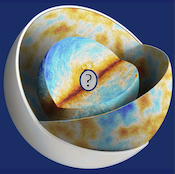Orateur
Description
Not long after the Planck space mission launch, it appeared that signals from the detectors operated at 100 mK of one of its instruments, HFI, were affected by cosmic rays. The heat dissipation in the detectors due to these particles hits created spurious signals appearing as glitches in the data. Further post-launch studies have allowed for most of these glitches to be removed.
Several space missions and balloon-borne instruments making use of highly sensitive 100 - 50 mK detectors are being planned. In order to avoid similar problems, prototype detectors need to be tested before for particle hits susceptibility, so that their design could be adapted for better immunity if needed, and the future data analysis can be planned for.
A large cryogenic facility has been developed for this purpose, allowing to irradiate cryogenic detectors and part of focal planes with particles such as protons of various energies with either an internal radioactive source or by coupling it to a particle accelerator. Our facility DRACuLA (Detector irRAdiation Cryogenic faciLity for Astrophysics) has been operated in front of the ALTO particle accelerator for a first test run in September 2022. A new test campaign has happened in may 2024 to study such effects by irradiating particles with different energy levels on transition-edge sensors (TES) prototypes.
We present this facility together with preliminary experimental results of the detector tests.

